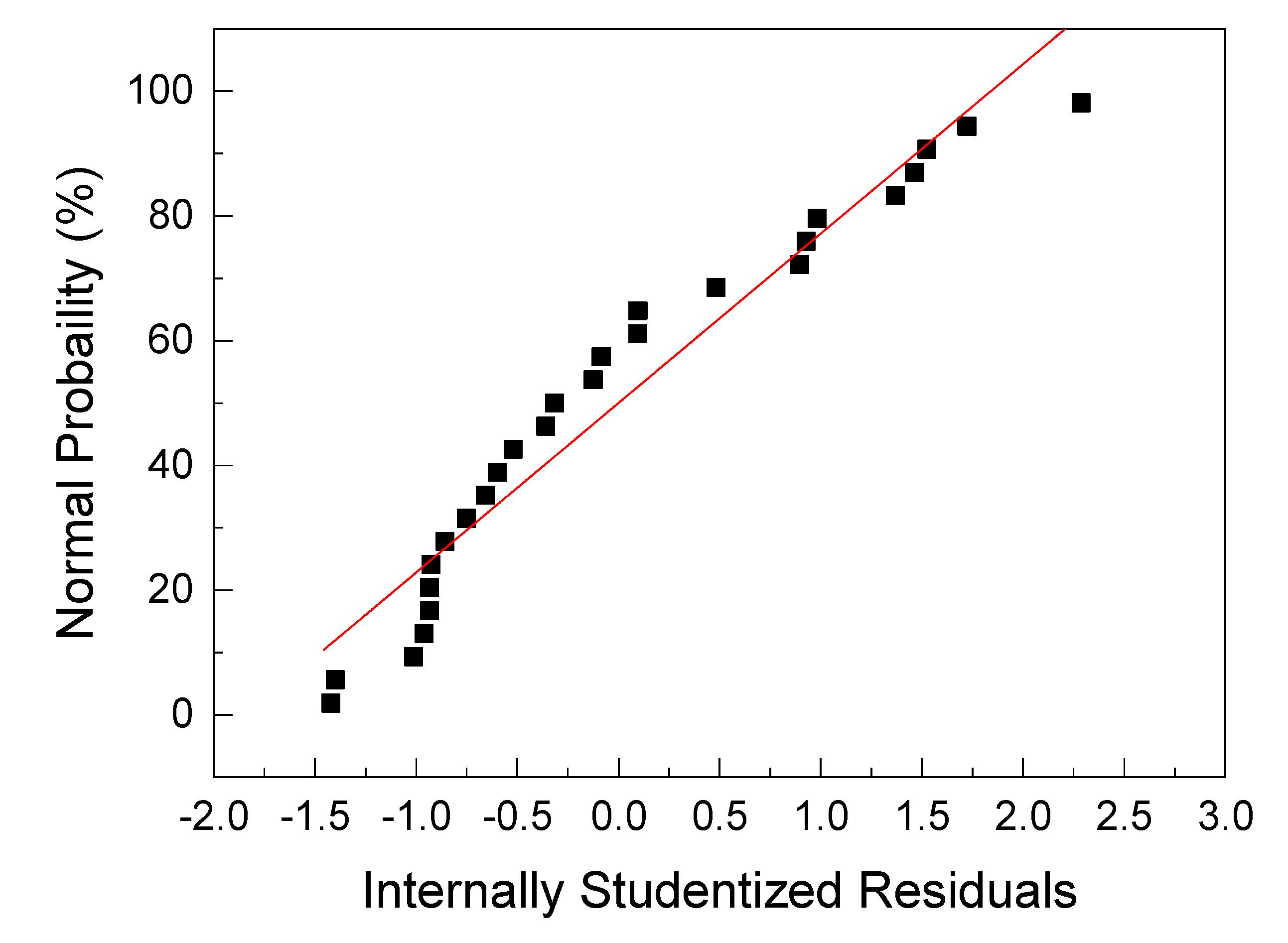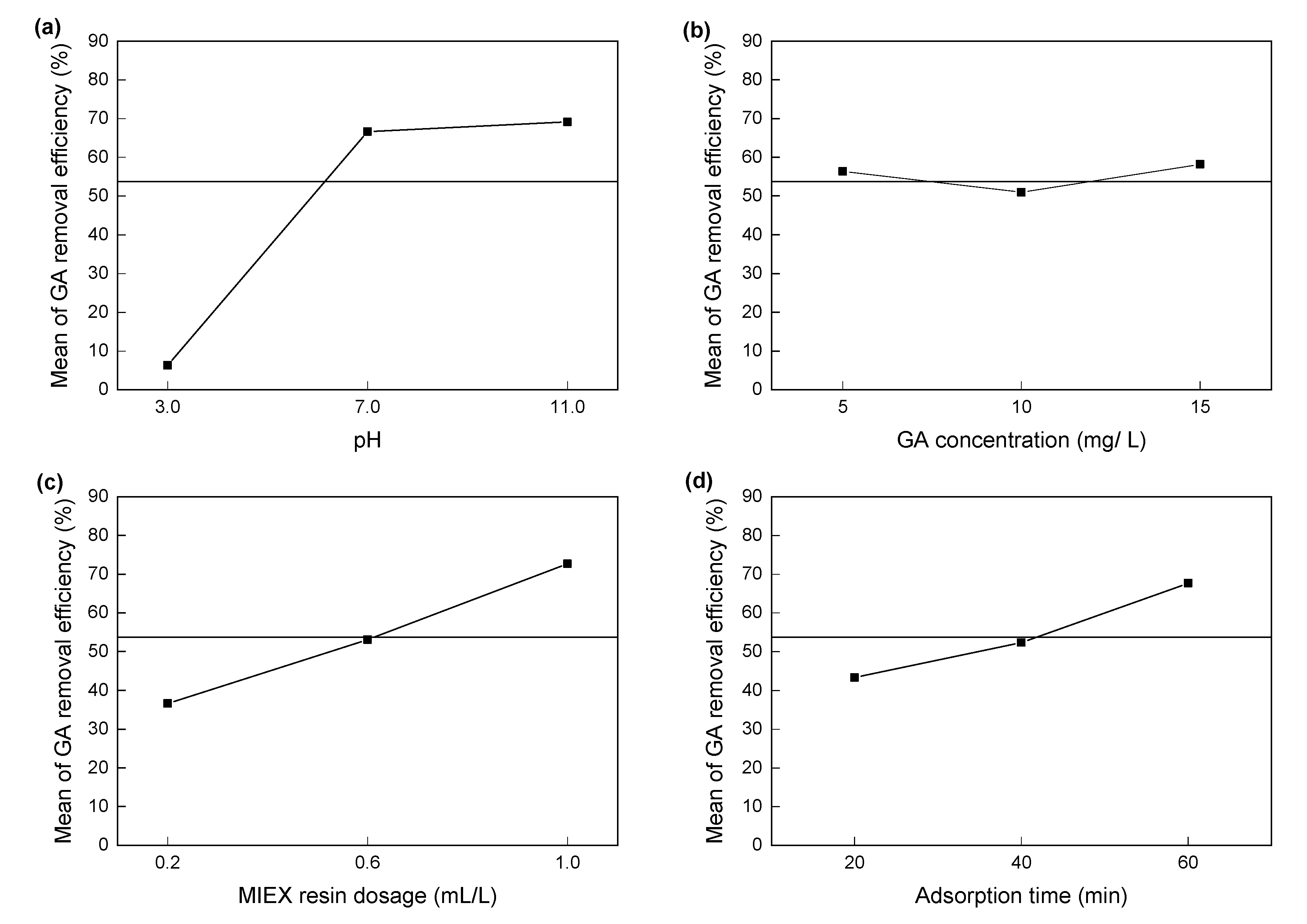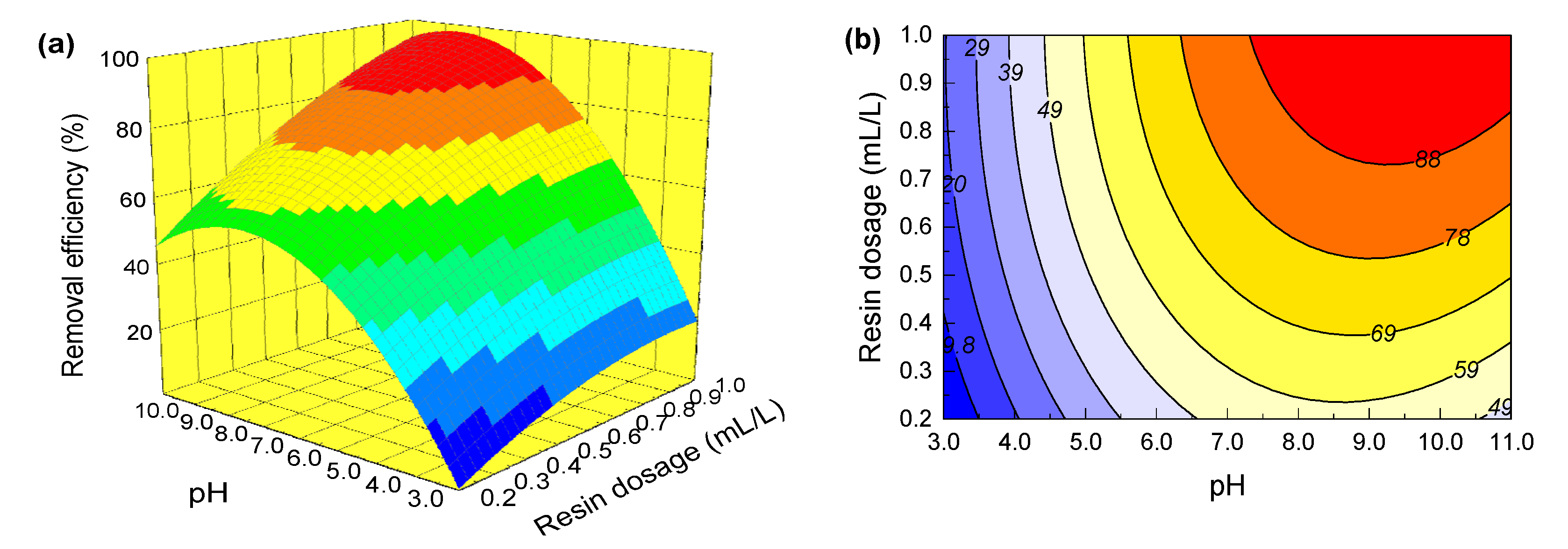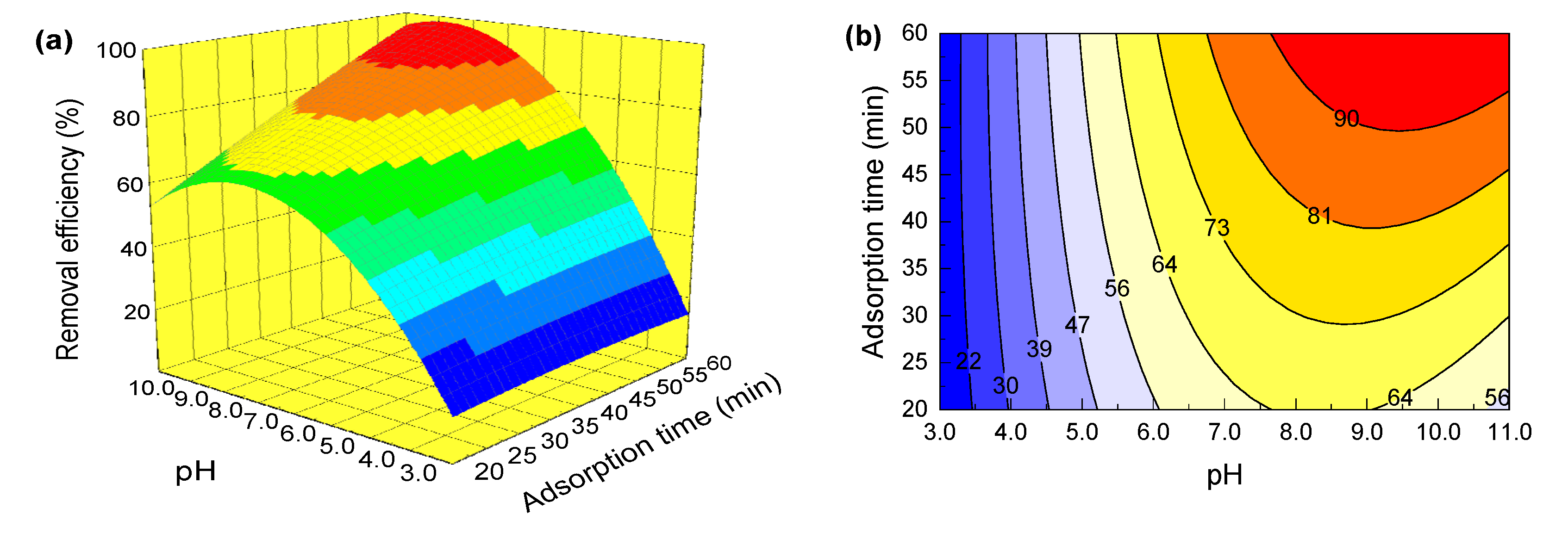Process Parameters Optimization of Gallic Acid Removal from Water by MIEX Resin Based on Response Surface Methodology
Abstract
1. Introduction
2. Materials and Methods
2.1. Materials and Reagents
2.2. Adsorption Tests
2.3. Analytical Methods
2.4. Experimental Design of Response Surface Methodology
3. Results
3.1. Fitting of Regression Model Equation
3.2. Reliability Analysis of the Regression Model Equation
3.3. Significant Degree of Independent Variables on GA Removal
3.4. Influences of Interactions between Variables on GA Removal
3.5. Optimal Adsorption Parameters and Confirmation Experiments
4. Conclusions
Author Contributions
Funding
Conflicts of Interest
References
- Awad, J.; van Leeuwen, J.; Chow, C.; Drikas, M.; Smernik, R.J.; Chittleborough, D.J.; Bestland, E. Characterization of dissolved organic matter for prediction of trihalomethane formation potential in surface and sub-surface waters. J. Hazard. Mater. 2016, 308, 430–439. [Google Scholar] [CrossRef] [PubMed]
- Shahamirifard, S.A.; Ghaedi, M.; Razmi, Z.; Hajati, S. A simple ultrasensitive electrochemical sensor for simultaneous determination of gallic acid and uric acid in human urine and fruit juices based on zirconia-choline chloride-gold nanoparticles-modified carbon paste electrode. Biosens. Bioelectron. 2018, 114, 30–36. [Google Scholar] [CrossRef] [PubMed]
- Bahrani, S.; Ghaedi, M.; Daneshfar, A. Fabrication of size controlled nanocomposite based on zirconium alkoxide for enrichment of gallic acid in biological and herbal tea samples. J. Chromatogr. B 2018, 1087–1088, 14–22. [Google Scholar] [CrossRef] [PubMed]
- Vilian, A.T.E.; Song, J.Y.; Lee, Y.S.; Hwang, S.-K.; Kim, H.J.; Jun, Y.S.; Huh, Y.S.; Han, Y.K. Salt-templated three-dimensional porous carbon for electrochemical determination of gallic acid. Biosens. Bioelectron. 2018, 117, 597–604. [Google Scholar] [CrossRef] [PubMed]
- Zhang, Z.; Pang, Q.; Li, M.; Zheng, H.; Chen, H.; Chen, K. Optimization of the condition for adsorption of gallic acid by Aspergillus oryzae mycelia using Box-Behnken design. Environ. Sci. Pollut. Res. Int. 2015, 22, 1085–1094. [Google Scholar] [CrossRef]
- Lu, L.L.; Lu, X.Y. Solubilities of gallic acid and its esters in water. J. Chem. Eng. Data 2007, 52, 37–39. [Google Scholar] [CrossRef]
- Fiuza, S.M.; Gomes, C.; Teixeira, L.J.; Girão da Cruz, M.T.; Cordeiro, M.N.D.S.; Milhazes, N.; Borges, F.; Marques, M.P.M. Phenolic acid derivatives with potential anticancer properties—A structure-activity relationship study. Part 1: Methyl, propyl and octyl esters of caffeic and gallic acids. Bioorg. Med. Chem. 2004, 12, 3581–3589. [Google Scholar] [CrossRef]
- Wu, Y.; Zhou, K.; Dong, S.; Yu, W.; Zhang, H. Recovery of gallic acid from gallic acid processing wastewater. Environ. Technol. 2015, 36, 661–666. [Google Scholar] [CrossRef]
- Víctor-Ortega, M.D.; Airado-Rodríguez, D. Revalorization of agro-industrial effluents based on gallic acid recovery through a novel anionic resin. Process Saf. Environ. Prot. 2018, 115, 17–26. [Google Scholar] [CrossRef]
- Boye, B.; Brillas, E.; Buso, A.; Farnia, G.; Flox, C.; Giomo, M.; Sandonà, G. Electrochemical removal of gallic acid from aqueous solutions. Electrochim. Acta 2007, 52, 256–262. [Google Scholar] [CrossRef]
- Benitez, F.J.; Real, F.J.; Acero, J.L.; Leal, A.I.; Garcia, C. Gallic acid degradation in aqueous solutions by UV/H2O2 treatment, Fenton’s reagent and the photo-Fenton system. J. Hazard. Mater. 2005, 126, 31–39. [Google Scholar] [CrossRef] [PubMed]
- Rabiei, M.; Sabahi, H.; Rezayan, A.H. Gallic acid-loaded montmorillonite nanostructure as a new controlled release system. Appl. Clay Sci. 2016, 119, 236–242. [Google Scholar] [CrossRef]
- Ahmat, A.M.; Thiebault, T.; Guégan, R. Phenolic acids interactions with clay minerals: A spotlight on the adsorption mechanisms of gallic acid onto montmorillonite. Appl. Clay Sci. 2019, 180, 105188. [Google Scholar] [CrossRef]
- Mammar, A.C.; Mouni, L.; Bollinger, J.C.; Belkhiri, L.; Bouzaza, A.; Assadi, A.A.; Belkacemi, H. Modeling and optimization of process parameters in elucidating the adsorption mechanism of gallic acid on activated carbon prepared from date stones. Sep. Sci. Technol. 2019, in press. [Google Scholar] [CrossRef]
- Cagnon, B.; Chedeville, O.; Cherrier, J.F.; Caqueret, V.; Porte, C. Evolution of adsorption kinetics and isotherms of gallic acid on an activated carbon oxidized by ozone: Comparison to the raw material. J. Taiwan Inst. Chem. Eng. 2011, 42, 996–1003. [Google Scholar] [CrossRef]
- Li, Y.; Lin, Y.; Wang, B.; Ding, S.; Qi, F.; Zhu, T. Carbon consumption of activated coke in the thermal regeneration process for flue gas desulfurization and denitrification. J. Clean. Prod. 2019, 228, 1391–1400. [Google Scholar] [CrossRef]
- Wang, J.N.; Li, A.M.; Xu, L.; Zhou, Y. Adsorption of tannic and gallic acids on a new polymeric adsorbent and the effect of Cu(II) on their removal. J. Hazard. Mater. 2009, 169, 794–800. [Google Scholar] [CrossRef]
- Kaleh, Z.; Geißen, S.U. Selective isolation of valuable biophenols from olive mill wastewater. J. Environ. Chem. Eng. 2016, 4, 373–384. [Google Scholar] [CrossRef]
- Watson, K.; Farré, M.J.; Knight, N. Enhanced coagulation with powdered activated carbon or MIEX® secondary treatment: A comparison of disinfection by-product formation and precursor removal. Water Res. 2015, 68, 454–466. [Google Scholar] [CrossRef]
- Rajca, M.; Bray, R.T.; Fitobor, K.; Golombek, K. Laser aser granulometer as an useful tool for selection of appropriate membranes used in the MIEX® DOC-UF/MF hybrid process. Arch. Metall. Mater. 2018, 63, 1133–1140. [Google Scholar] [CrossRef]
- Wolska, M. An evaluation of organic substance fraction removal during ion exchange with MIEX-DOC resin. Environ. Sci. Pollut. Res. Int. 2015, 22, 10360–10366. [Google Scholar] [CrossRef] [PubMed]
- Jutaporn, P.; Laolertworakul, W.; Armstrong, M.D.; Coronell, O. Fluorescence spectroscopy for assessing trihalomethane precursors removal by MIEX resin. Water Sci. Technol. 2019, 79, 820–832. [Google Scholar] [CrossRef] [PubMed]
- Gan, X.J.; Karanfil, T.; Bekaroglu, S.S.K.; Shan, J.H. The control of N-DBP and C-DBP precursors with MIEX®. Water Res. 2013, 47, 1344–1352. [Google Scholar] [CrossRef] [PubMed]
- Drikas, M.; Dixon, M.; Morran, J. Removal of MIB and geosmin using granular activated carbon with and without MIEX pre-treatment. Water Res. 2009, 43, 5151–5159. [Google Scholar] [CrossRef]
- Neale, P.A.; Mastrup, M.; Borgmann, T.; Schafer, A.I. Sorption of micropollutant estrone to a water treatment ion exchange resin. J. Environ. Monit. 2010, 12, 311–317. [Google Scholar] [CrossRef]
- Liu, Z.Q.; Yan, X.M.; Drikas, M.; Zhou, D.N.; Wang, D.S.; Yang, M.; Qu, J.H. Removal of bentazone from micro-polluted water using MIEX resin: Kinetics, equilibrium, and mechanism. J. Environ. Sci. 2011, 23, 381–387. [Google Scholar] [CrossRef]
- Ding, L.; Lu, X.; Deng, H.P.; Zhang, X.X. Adsorptive removal of 2,4-dichlorophenoxyacetic acid (2,4-D) from aqueous solutions using MIEX resin. Ind. Eng. Chem. Res. 2012, 51, 11226–11235. [Google Scholar] [CrossRef]
- López-Ortiz, C.M.; Sentana-Gadea, I.; Varó-Galvañ, P.J.; Maestre-Pérez, S.E.; Prats-Rico, D. Effect of magnetic ion exchange (MIEX®) on removal of emerging organic contaminants. Chemosphere 2018, 208, 433–440. [Google Scholar] [CrossRef]
- Rajca, M. The influence of selected factors on the removal of anionic contaminants from water by means of ion exchange MIEX® DOC process. Arch. Environ. Prot. 2012, 38, 115–121. [Google Scholar] [CrossRef][Green Version]
- Bezerra, M.A.; Santelli, R.E.; Oliveira, E.P.; Villar, L.S.; Escaleira, L.A. Response surface methodology (RSM) as a tool for optimization in analytical chemistry. Talanta 2008, 76, 965–977. [Google Scholar] [CrossRef]
- Karimifard, S.; Alavi Moghaddam, M.R. Application of response surface methodology in physicochemical removal of dyes from wastewater: A critical review. Sci. Total Environ. 2018, 640–641, 772–797. [Google Scholar] [CrossRef] [PubMed]
- Yang, Y.; Ding, Q.; Yang, M.; Wang, Y.; Liu, N.; Zhang, X. Magnetic ion exchange resin for effective removal of perfluorooctanoate from water: Study of a response surface methodology and adsorption performances. Environ. Sci. Pollut. Res. Int. 2018, 25, 29267–29278. [Google Scholar] [CrossRef] [PubMed]
- Uysal, S.; Cvetanovic, A.; Zengin, G.; Durovic, S.; Zekovic, Z.; Aktumsek, A. Effects of orange leaves extraction conditions on antioxidant and phenolic content: Optimization using response surface methodology. Anal. Lett. 2018, 51, 1505–1519. [Google Scholar] [CrossRef]
- Dao, L.; Friedman, M. Chlorogenic acid content of fresh and processed potatoes determined by ultraviolet spectrophotometry. J. Agric. Food. Chem. 1992, 40, 2152–2156. [Google Scholar] [CrossRef]
- Cho, I.-H.; Zoh, K.-D. Photocatalytic degradation of azo dye (Reactive Red 120) in TiO2/UV system: Optimization and modeling using a response surface methodology (RSM) based on the central composite design. Dyes Pigments 2007, 75, 533–543. [Google Scholar] [CrossRef]
- Hiew, B.Y.Z.; Lee, L.Y.; Lai, K.C.; Gan, S.; Thangalazhy-Gopakumar, S.; Pan, G.-T.; Yang, T.C.-K. Adsorptive decontamination of diclofenac by three-dimensional graphene-based adsorbent: Response surface methodology, adsorption equilibrium, kinetic and thermodynamic studies. Environ. Res. 2019, 168, 241–253. [Google Scholar] [CrossRef]
- Zhang, X.X.; Lu, X.; Li, S.; Zhong, M.Y.; Shi, X.D.; Luo, G.; Ding, L. Investigation of 2,4-dichlorophenoxyacetic acid adsorption onto MIEX resin: Optimization using response surface methodology. J. Taiwan Inst. Chem. Eng. 2014, 45, 1835–1841. [Google Scholar] [CrossRef]
- Ahmad, A.L.; Derek, C.J.C.; Zulkali, M.M.D. Optimization of thaumatin extraction by aqueous two-phase system (ATPS) using response surface methodology (RSM). Sep. Purif. Technol. 2008, 62, 702–708. [Google Scholar] [CrossRef]
- Liu, J.; Yan, M.; Zhang, Y.K.; Du, K.F. Study of glutamate-modified cellulose beads for Cr(III) adsorption by response surface methodology. Ind. Eng. Chem. Res. 2011, 50, 10784–10791. [Google Scholar] [CrossRef]
- Halder, G.; Dhawane, S.; Barai, P.K.; Das, A. Optimizing chromium (VI) adsorption onto superheated steam activated granular carbon through response surface methodology and artificial neural network. Environ. Prog. Sustain. Energy 2015, 34, 638–647. [Google Scholar] [CrossRef]
- Anupam, K.; Dutta, S.; Bhattacharjee, C.; Datta, S. Adsorptive removal of chromium (VI) from aqueous solution over powdered activated carbon: Optimisation through response surface methodology. Chem. Eng. J. 2011, 173, 135–143. [Google Scholar] [CrossRef]
- Bingol, D.; Tekin, N.; Alkan, M. Brilliant yellow dye adsorption onto sepiolite using a full factorial design. Appl. Clay Sci. 2010, 50, 315–321. [Google Scholar] [CrossRef]
- Zhang, Z.; Zheng, H. Optimization for decolorization of azo dye acid green 20 by ultrasound and H2O2 using response surface methodology. J. Hazard. Mater. 2009, 172, 1388–1393. [Google Scholar] [CrossRef] [PubMed]
- Zhang, K.; Cheung, W.H.; Valix, M. Roles of physical and chemical properties of activated carbon in the adsorption of lead ions. Chemosphere 2005, 60, 1129–1140. [Google Scholar] [CrossRef] [PubMed]
- Palanikumar, K.; Davim, J.P. Assessment of some factors influencing tool wear on the machining of glass fibre-reinforced plastics by coated cemented carbide tools. J. Mater. Process. Technol. 2009, 209, 511–519. [Google Scholar] [CrossRef]
- Zhang, B.; Han, X.; Gu, P.; Fang, S.; Bai, J. Response surface methodology approach for optimization of ciprofloxacin adsorption using activated carbon derived from the residue of desilicated rice husk. J. Mol. Liq. 2017, 238, 316–325. [Google Scholar] [CrossRef]
- Bahrami, M.; Amiri, M.J.; Bagheri, F. Optimization of the lead removal from aqueous solution using two starch based adsorbents: Design of experiments using response surface methodology (RSM). J. Environ. Chem. Eng. 2019, 7, 102793. [Google Scholar] [CrossRef]
- Song, X.R.; Chai, Z.H.; Zhu, Y.; Li, C.L.; Liang, X.Q. Preparation and characterization of magnetic chitosan-modified diatomite for the removal of gallic acid and caffeic acid from sugar solution. Carbohydr. Polym. 2019, 219, 316–327. [Google Scholar] [CrossRef]
- Nourani, M.; Baghdadi, M.; Javan, M.; Bidhendi, G.N. Production of a biodegradable flocculant from cotton and evaluation of its performance in coagulation-flocculation of kaolin clay suspension: Optimization through response surface methodology (RSM). J. Environ. Chem. Eng. 2016, 4, 1996–2003. [Google Scholar] [CrossRef]




| Factor | Code | Level | ||
|---|---|---|---|---|
| −1 | 0 | 1 | ||
| Solution pH | X1 | 3.0 | 7.0 | 11.0 |
| GA concentration (mg/L) | X2 | 5 | 10 | 15 |
| MIEX resin dosage (mL/L) | X3 | 0.2 | 0.6 | 1 |
| Adsorption time/min | X4 | 20 | 40 | 60 |
| Run | Actual Value | Coded Value | Removal Efficiency, E (%) | |||||||
|---|---|---|---|---|---|---|---|---|---|---|
| X1 | X2 | X3 | X4 | X1 | X2 | X3 | X4 | Experimental | Predicted | |
| 1 | 3.0 | 15 | 0.6 | 40 | −1 | 1 | 0 | 0 | 9.57 | |
| 2 | 11.0 | 10 | 1.0 | 40 | 1 | 0 | 1 | 0 | 89.42 | |
| 3 | 3.0 | 10 | 0.6 | 60 | −1 | 0 | 0 | 1 | 10.48 | |
| 4 | 7.0 | 10 | 0.6 | 40 | 0 | 0 | 0 | 0 | 73.74 | |
| 5 | 3.0 | 5 | 0.6 | 40 | −1 | −1 | 0 | 0 | 7.29 | |
| 6 | 3.0 | 10 | 0.2 | 40 | −1 | 0 | −1 | 0 | 0.65 | |
| 7 | 11.0 | 10 | 0.2 | 40 | 1 | 0 | −1 | 0 | 45.47 | |
| 8 | 7.0 | 5 | 0.6 | 20 | 0 | −1 | 0 | −1 | 53.43 | |
| 9 | 7.0 | 10 | 1.0 | 60 | 0 | 0 | 1 | 1 | 93.56 | |
| 10 | 7.0 | 5 | 1.0 | 40 | 0 | −1 | 1 | 0 | 81.52 | |
| 11 | 7.0 | 15 | 1.0 | 40 | 0 | 1 | 1 | 0 | 85.29 | |
| 12 | 7.0 | 5 | 0.6 | 60 | 0 | −1 | 0 | 1 | 77.90 | |
| 13 | 7.0 | 10 | 0.6 | 40 | 0 | 0 | 0 | 0 | 73.74 | |
| 14 | 3.0 | 10 | 0.6 | 20 | −1 | 0 | 0 | −1 | 1.07 | |
| 15 | 7.0 | 15 | 0.6 | 60 | 0 | 1 | 0 | 1 | 79.56 | |
| 16 | 7.0 | 5 | 0.2 | 40 | 0 | −1 | −1 | 0 | 47.32 | |
| 17 | 11.0 | 10 | 0.6 | 20 | 1 | 0 | 0 | −1 | 49.07 | |
| 18 | 7.0 | 10 | 1.0 | 20 | 0 | 0 | 1 | −1 | 67.93 | |
| 19 | 11.0 | 5 | 0.6 | 40 | 1 | −1 | 0 | 0 | 70.68 | |
| 20 | 3.0 | 10 | 1.0 | 40 | −1 | 0 | 1 | 0 | 18.71 | |
| 21 | 7.0 | 15 | 0.6 | 20 | 0 | 1 | 0 | −1 | 55.39 | |
| 22 | 7.0 | 10 | 0.2 | 60 | 0 | 0 | −1 | 1 | 56.10 | |
| 23 | 7.0 | 10 | 0.6 | 40 | 0 | 0 | 0 | 0 | 73.74 | |
| 24 | 11.0 | 10 | 0.6 | 60 | 1 | 0 | 0 | 1 | 88.31 | |
| 25 | 11.0 | 15 | 0.6 | 40 | 1 | 1 | 0 | 0 | 72.01 | |
| 26 | 7.0 | 10 | 0.2 | 20 | 0 | 0 | −1 | −1 | 33.08 | |
| 27 | 7.0 | 15 | 0.2 | 40 | 0 | 1 | −1 | 0 | 47.17 | |
| Source | Sum of Squares | Degree of Freedom | Mean Square | F | Prob > F |
|---|---|---|---|---|---|
| Model | 23,701.35 | 14 | 1692.95 | 36.57 | <0.0001 |
| X1-pH | 11,873.99 | 1 | 11,873.99 | 256.47 | <0.0001 |
| X2-GA concentration | 9.84 | 1 | 9.84 | 0.21 | 0.5392 |
| X3-Resin dosage | 3921.36 | 1 | 3921.36 | 84.70 | <0.0001 |
| X4-Adsorption time | 1774.60 | 1 | 1774.60 | 38.33 | <0.0001 |
| X1X2 | 0.22 | 1 | 0.22 | 0.01 | 0.9456 |
| X1X3 | 60.70 | 1 | 60.70 | 1.31 | 0.2745 |
| X1X4 | 222.61 | 1 | 222.61 | 4.81 | 0.0488 |
| X2X3 | 3.85 | 1 | 3.85 | 0.08 | 0.7779 |
| X2X4 | 0.03 | 1 | 0.03 | 0.00 | 0.9823 |
| X3X4 | 1.70 | 1 | 1.70 | 0.04 | 0.8514 |
| X12 | 5323.96 | 1 | 5323.96 | 114.99 | <0.0001 |
| X22 | 27.14 | 1 | 27.14 | 0.59 | 0.4586 |
| X32 | 202.25 | 1 | 202.25 | 4.37 | 0.0586 |
| X42 | 128.75 | 1 | 128.75 | 2.78 | 0.1213 |
| Residual | 555.57 | 12 | 46.30 | ||
| Lack of fit | 543.97 | 10 | 54.40 | 9.38 | 0.1002 |
| Pure error | 11.60 | 2 | 5.80 | ||
| Cor total | 24,256.92 | 26 |
| pH | GA Concentration (mg/L) | Resin Dosage (mL/L) | Adsorption Time (min) | Removal Efficiency of GA, E (%) | |
|---|---|---|---|---|---|
| Predicted | Experimental | ||||
| 9.17 | 8.07 | 0.98 | 46.43 | 98.99 | |
© 2020 by the authors. Licensee MDPI, Basel, Switzerland. This article is an open access article distributed under the terms and conditions of the Creative Commons Attribution (CC BY) license (http://creativecommons.org/licenses/by/4.0/).
Share and Cite
Zhou, Q.; Ding, L.; Zhu, Y.; Zhong, M.; Yang, C. Process Parameters Optimization of Gallic Acid Removal from Water by MIEX Resin Based on Response Surface Methodology. Processes 2020, 8, 273. https://doi.org/10.3390/pr8030273
Zhou Q, Ding L, Zhu Y, Zhong M, Yang C. Process Parameters Optimization of Gallic Acid Removal from Water by MIEX Resin Based on Response Surface Methodology. Processes. 2020; 8(3):273. https://doi.org/10.3390/pr8030273
Chicago/Turabian StyleZhou, Qiang, Lei Ding, Yunhua Zhu, Meiying Zhong, and Chuchu Yang. 2020. "Process Parameters Optimization of Gallic Acid Removal from Water by MIEX Resin Based on Response Surface Methodology" Processes 8, no. 3: 273. https://doi.org/10.3390/pr8030273
APA StyleZhou, Q., Ding, L., Zhu, Y., Zhong, M., & Yang, C. (2020). Process Parameters Optimization of Gallic Acid Removal from Water by MIEX Resin Based on Response Surface Methodology. Processes, 8(3), 273. https://doi.org/10.3390/pr8030273




